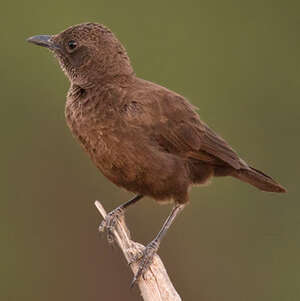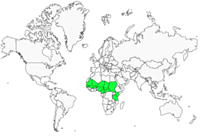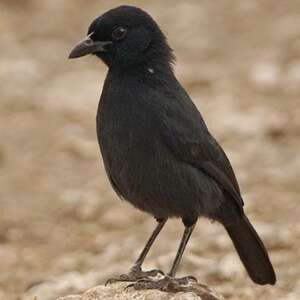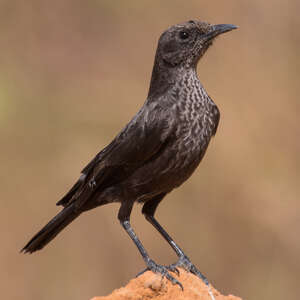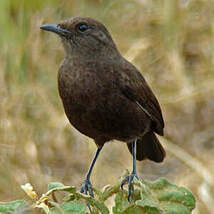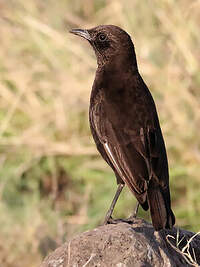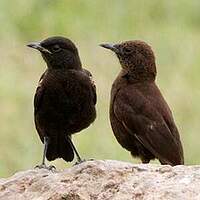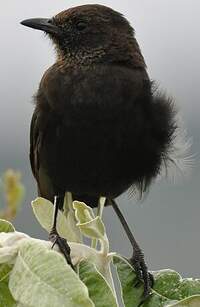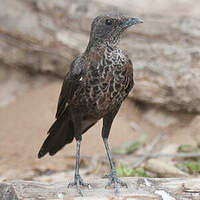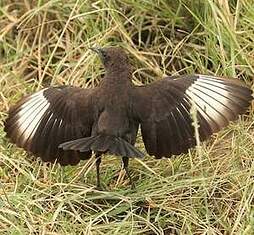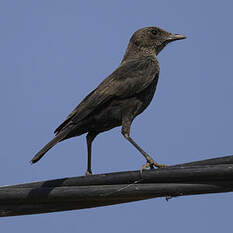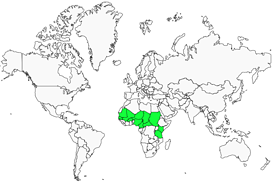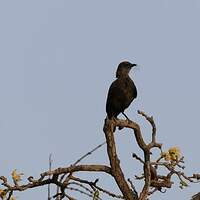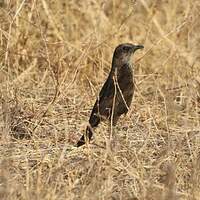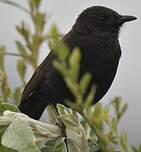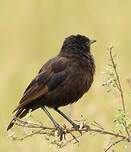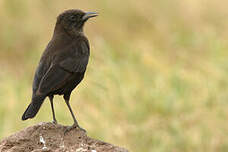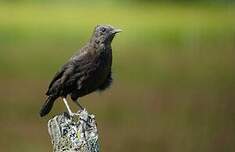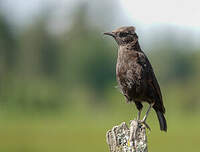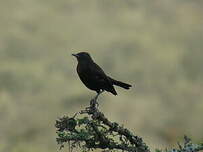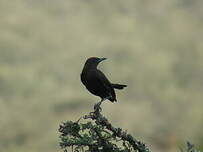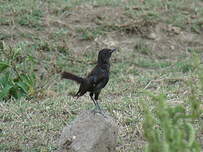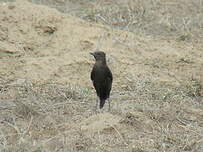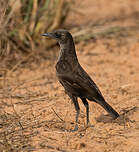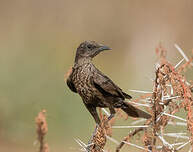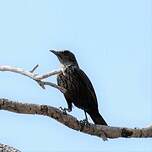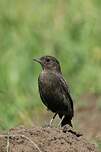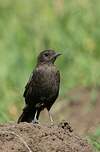Anteater Chat
Myrmecocichla aethiops - Traquet brun
Identification
Medium-sized with long legs, short rounded wings, and a short squared tail, the Anteater Chat is a quite distinctive bird. It is entirely dark brown, although it can appear black from a distance. The species is distinguished by the wide white patch visible on the open wing at the wrist. The primary remiges are indeed mostly white with a brown tip and a brown line on their anterior edge. This can be seen well when flying or when the bird displays with outstretched wings. The beak and legs are black. There is no marked sexual dimorphism. The female simply tends to be slightly paler. The juvenile resembles the adult but its throat and breast are mottled.
Subspecific information 3 subspecies
- Myrmecocichla aethiops aethiops (Senegal and Gambia to Chad and n Cameroon)
- Myrmecocichla aethiops sudanensis (wc and c Sudan)
- Myrmecocichla aethiops cryptoleuca (w and c Kenya to n Tanzania)
Foreign names
- Traquet brun,
- Zorzal hormiguero septentrional,
- chasco-formigueiro-setentrional,
- Rußschmätzer,
- száheli hangyászcsuk,
- Bruine Miertapuit,
- Sassicola mangiaformiche del nord,
- nordlig termitskvätta,
- Termittskvett,
- skaliarik tmavý,
- bělořit termití,
- Myrepikker,
- sahelinmuurahaistasku,
- merla formiguera septentrional,
- Mauraskvetta,
- smolarek brunatny,
- skudru čakstīte,
- čadasti termitar,
- Эфиопский муравьиный чекан,
- アリヒタキ,
- 蚁䳭,
- 北方蟻鵖,
Voice song and cries
The song of the Anteater Chat is a long, rather monotonous musical suite. Clear whistles, whispers and brief, guttural sounds sometimes accompany wing movements and body swaying forward: chwerchiwee tserk, chiwerchiwee, tsick-tuweee tuwee, teeruweeer tsick, tchu chiwer. The contact note between individuals is a loud, slightly gritty tseeo or ttsuii. The alarm is given with a sharp piit.
Habitat
The Anteater Chat prefers grassy areas such as savannas dotted with scattered bushes and almost always with termite mounds. Semi-open mountain forests with large trees like acacias, nearby agricultural land and roadside edges also suit it. It is also common to see it in rocky environments as well as in quarries. It can be seen from 1,500 to 3,000 meters in altitude, for example above 1,700 meters in Kenya and in the northwest of Tanzania.
Behaviour character trait
The Anteater Chat usually lives in pairs or small family groups which can count up to 15 individuals, both adults, immature and young.
This bird is not afraid and can easily be approached. It can easily be spotted when perched on a termite mound, stake, electric post or bush. It spends long periods on the ground pecking on the ground. It inspects old termite mounds or old burrows. But most of the time, it hunts while perched up and surveying its surroundings, in search of potential prey to dive onto.Dietfeeding habits
The Anteater Chat is mainly insectivorous. It feeds primarily on Lepidoptera (imagos and caterpillars), termites, beetles, ants, grasshoppers and so on. It does not hesitate to grab a few spiders along the way, as well as small vertebrates. It occasionally eats fruits such as those from Withania somnifera, Indian Ginseng.
Reproduction nesting
The Anteater Chat is monogamous and a couple can remain united for several years. This characteristic, combined with the persistence of family groups, is the origin of a high rate of consanguinity.
Reproduction coincides with the rainy season. The Anteater Chat is very territorial and can be very aggressive towards intruders. To seduce his partner, the male perches and energetically shakes his open wings, displaying his white primary remiges. The female responds by trembling her wings, which she carries drooping. The nest built by the two partners consists of vegetal elements, dry grass, fibers, and roots. It is placed at the bottom of a 1.5-meter-long tunnel that the couple dug together, for example in a riverbank, or in an old burrow of another species, rodent or otherwise. The female lays 2-5 pure white eggs that are slightly shiny which she incubates alone for 14-16 days. In some regions, the temperature is such that the natural heat of the nest is enough to ensure development. The chicks are fed by both parents for 21-23 days. The young from the previous clutch, still within the family group, help to feed the last-born. There is little data on the reproductive success of the Anteater Chat. It is known, however, that the Great Indicator frequently parasitizes the clutches.Geographic range
The Anteater Chat occupies a sub-Saharan strip from Senegal to South Sudan, with some northern locations in Sudan and Chad. A different subspecies is found in south-eastern Kenya and northern Tanzania. The bird is usually sedentary, but in Mauritania it has been noted to migrate northwards during the rainy season.
Threats - protection
Sources of information
- IOC World Bird List (v14.1), Gill, F and D Donsker (Eds). 2024-04-18.
- Robins and Chats, Peter Clement, Chris Rose
- HBW Alive,
- BirdLife International, BirdLife International
Other sources of interest
 Specification sheet created on
22/07/2023 by Nathalie Santa Maria
Specification sheet created on
22/07/2023 by Nathalie Santa MariaTranslation by AI Oiseaux.net
published: 16-03-2017 - Updated: 20-03-2017
© 1996-2024 Oiseaux.net
- Accipitriformes
- Aegotheliformes
- Anseriformes
- Apodiformes
- Apterygiformes
- Bucerotiformes
- Caprimulgiformes
- Cariamiformes
- Casuariiformes
- Charadriiformes
- Ciconiiformes
- Coliiformes
- Columbiformes
- Coraciiformes
- Cuculiformes
- Eurypygiformes
- Falconiformes
- Galliformes
- Gaviiformes
- Gruiformes
- Leptosomiformes
- Mesitornithiformes
- Musophagiformes
- Nyctibiiformes
- Opisthocomiformes
- Otidiformes
- Passeriformes
- Pelecaniformes
- Phaethontiformes
- Phoenicopteriformes
- Piciformes
- Podargiformes
- Podicipediformes
- Procellariiformes
- Psittaciformes
- Pterocliformes
- Rheiformes
- Sphenisciformes
- Steatornithiformes
- Strigiformes
- Struthioniformes
- Suliformes
- Tinamiformes
- Trogoniformes

